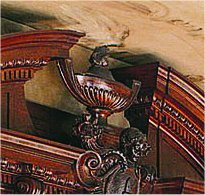

|
<<< Continued from previous page Karl Bitter had been hired by Hunt to do the sculptural work for Biltmore; in early 1896 he was hard at work on the decorative fireplace, mantelpiece, and andirons for the library. His work was typically allegorical; in an article published by the Architectural League of New York, Bitter describes the colossal carved wooden figures on either side of the tapestry over the mantel as symbolizing Philosophy with her globe and Health with her serpent and patera. Biltmore has named them Demeter, goddess of earth and Hestia, goddess of the hearth. Above the tapestry, and also carved in French walnut, is the image of an oil lamp to symbolize knowledge and enlightenment.

This motif also occurs elsewhere in the library. The tapestry hanging over the fireplace today is not the original; it is believed to have been placed there by George Vanderbilt's son-in-law John Cecil in the 1920s. The disappearance of the original is a mystery, During the 15 years I've been visiting the house I've heard many suggestions - all speculation. There is one photograph of the library with the original tapestry in it from around 1910, but the subject is unclear. Curators at Biltmore have theorized that it may have been called Tree of Life or Tree of Knowledge. Close inspection of the photo with high powered magnifiers suggests the story of Gulliver at Lilliput, but we may never know what the subject really was or what became of it. No historic house is complete without the occasional secret compartment, and there are several in the library at Biltmore. On either side of the fireplace there are panels that open and are quite deep, and beside every door in the library are panels with small hinges that reveal hidden compartments which are some inches deep. What were they for? Rick King, Vice President of Biltmore House, told me they were empty when he arrived several decades ago and suspects they were used for maps or plans, but no one knows for sure. Not hidden but suggestive of mysterious, late-night excursions, an elaborate spiral staircase leads to the balcony, and from there one can reach the bedrooms on the second floor. One can imagine a houseguest, or George Vanderbilt himself, quietly descending these stairs in search of bedtime reading. The Den, which is off the library on the back of the house, is something of a mystery too. The door leading into it features a carved monk holding a finger to his mouth - as if to say, "Shhh" - and there appears to be a knife in his back. It has been theorized that this is St. Peter the Martyr. The den itself, which is no longer open to the public, opens to a high, blue ceiling and a black and white tile floor. Some have reported that Vanderbilt used it for meditation; a newspaper reporter, when shown the room by Vanderbilt, wrote that he had referred to it as a scriptorium - a place where he worked on translating books into Sanskrit and Hebrew. And in the end, that is what a visit to the library at Biltmore is all about - a chance to gaze in awe at a wonderful collection in magnificent surroundings and to wonder what it might have been like to take a book from the shelf and sit in a leather chair by the fire to read. All bibliophiles know that books transport us to other places and times. Perhaps some libraries can perform the same magic. The library at Biltmore is our chance to share George Washington Vanderbilt's dream.
< to previous article
to next article >
Questions or comments?
| Forum
| Store
| Publications
| BookLinks
| BookSearch
| BookTopics
| Archives
| Advertise
| AboutUs
| ContactUs
| Search Site
| Site Map
| Google Site Map
Store - Specials
| BookHunt
| BookShelf
| Gold Edition & BookThink's Quarterly Market Report
| DomainsForSale
| BookThinker newsletter - free
Copyright 2003-2011 by BookThink LLC
|

|
|